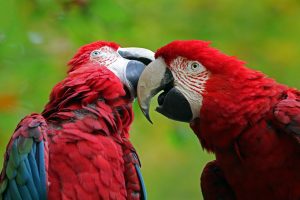
In the metaphysical world where everything is made of fire, earth, air, and water, air is the realm of thoughts and ideas. Breath is an expression of air. Many cultures believe that breath and spirit are the same thing. Voice is an expression of air, too. How can podcasters use these concepts to create their best work? Through ritual.
The association of sound with creativity is as old as time. The creation myths of many cultures tell the story about how sound created the world. In Australia, the Goddess Barnumbirr rose in the sky before dawn and sang the land and all its creatures into being. In Ancient Egypt, the God Thoth created the world with his voice. The Pueblo Native Americans tell the story of the spider who spun her web as she sang the world into being.
People in the ancient world made sounds, too. They used rattles, sticks, drums, and chants to summon their ancestors, to ease childbirth, to send the dying on their new journey. They sang, too. The human voice was, and still is, the most common instrument. A shout, a whisper, a lecture, a prayer, a scream, a moan — all move the air in ways that can change lives. In The Book of Air: The Art of Paying Attention, author and astrologer Steven Forrest, talks about air as a linking element, how air “connects our hearts and our minds to the world around us.” Such is the power of our voice.
Wave Forms, Thought Forms, and Puppies
In the book, Shifting Frequencies, author Jonathan Goldman talks about how we can learn to breathe through the chakras, the energy wheels in the body. He says that when we make the “ah” sound while breathing through the heart chakra, it is “a way to draw in, then radiate, the energy of love.”
I’m reminded of the 2019 Podcast Movement conference in Orlando. Launchpad, one of the vendors, wanted to attract people to their booth. They let attendees know that if they stopped by the Launchpad booth, they could drink free beer and play with puppies.
Picture it — grown men and women playing with little, sweet, squirming puppies. Listen. Hear those same men and women smiling as they say, “Ahhhhh.” As those people leave the booth, others take their place. More “ahhhhhhs.” More love. Layers and layers of loving sounds embraced that space. I wasn’t at the conference but from what I’ve been told, that booth proved very popular, and not because of the beer.
Sounds, words and events create thoughtforms. Their energy lingers long after the event is over, long after the words have been said, long after the sound has been made. Jonathan Goldman says that’s true, even when the action occurred lifetimes ago.
Have you ever walked into an empty room and felt anger or sorrow? I believe those feelings were created by people who were in the room before you — hours, days, years, generations before you. The energy can be positive, too. A friend told me the first time she traveled to Ireland, she was overwhelmed with the feeling that she was finally home.
As a long-time ritualist and now a podcaster, I’m mindful of the thoughtforms I’m creating in the physical space where I record my podcast, Ritual Recipes. I have an artificial tree filled with twinkling fairy lights. Candles and crystal balls rim the room. A rainstick and a red leather frame drum sit in a corner. Chimes hang from the ceiling. A diffuser fills the air with the scents of essential oils, primarily frankincense. Family, friends, and the occasional contractor have all commented on the zen-like atmosphere. The space supports and affirms my creativity. To me, this room is sacred. I feel it every time I cross the threshold.
How do you feel when you enter the space where you create your podcast? The waveforms you produce with your voice are your wallpaper. A friend and writing mentor Pat Carr taught me that I am responsible for the energy I put into the world through my words. Are they true? Are they helpful? The same is true for the energy you put into the world with your voice. Is what you’re saying true? Is it helpful? In 1839, English author Edward Bulwer-Lytton said, “The pen is mightier than the sword.” So is a podcast.
Ritual: Your Secret Sound
In The Secret Power of Music, author David Tame talks about mantras — certain one-syllable words or sounds endowed with spiritual energy — and how you can combine mantras to create your “secret name.” He says the concept was widespread in the ancient world and can still be found in some cultures today. Each person is also said to have a personal melody. That concept inspired the ritual “Your Secret Sound.”
Tame suggests working with one-syllable sounds that begin with the letters H, R, S, L, V, and Y. The sounds rhyme with simple words like home, mom, knee, blue, and hum. For example: hum, rum, sum, lum, vum, yum. Or, hee, ree, see, lee, vee, yee.
Then make up your own one-syllable sounds with other letters. Pick three or four sounds that you find harmonious. Pick another three or four sounds. Add another combination. String them all together. You might come up with something like: Oh Ta Ma Tum / Yum See Vee Yum.
Add notes to each syllable. Play with the sounds. Eventually, a melody will come to you. This isn’t a matter of being right or wrong. It’s about finding combinations of sounds that resonate with you. Get creative!
Once you get your personal sound, keep it to yourself. That’s because the ancients believed that everything has its own vibration. If you could imitate another’s vibration — like the howl of a wolf, or the howl of the wind — you could control the wolf, or the wind.
Since humans can produce more sounds than any other creatures, humans have an advantage in gaining the power over other creatures and over nature herself. I can’t say I like the idea of having power over anyone or anything else. But I do like the idea of resonating with the energy of the world in order to help save the world.
To some, this might sound far-fetched. To others, it might explain why you’re drawn
- to a place, like the beach with its crashing waves, or Scotland and the primal, ancestral, droning sound of bagpipes, or
- to an animal, like the buzz of bees, the whinney of a horse, the purr of a cat, the exotic symphony of birds in a rainforest, or the hum of cicadas on a summer night, or
- to a certain kind of weather, like soft rain or the crack of lightning or the spiritual silence of snow, or
- to a tree, like the apple when its fruit falls to the ground with a plop, or the waking sound of sap rising in a maple tree in winter, the snap and scream of wet wood as it’s burned, or the summer exhale of a linden tree as it releases its honey-lemon perfume.
To help you find your secret sound, pick a place, an animal, a tree, a type of weather — or anything else in nature. Search for videos that let you see and hear what you’ve picked. Watch for a few minutes then close your eyes and listen. Just listen.
Pay attention to your breath. Slow it down. What sound would you give to that snow? Or to that maple tree? Or that fire? Just make it up. Pretend. This exercise isn’t for anyone’s ears but yours, so don’t hold back. This is about associating sounds with something that feels “right” to you, something that feels like it’s part of you. Let nature help you find your secret sound.
Make your secret sound before you record every podcast episode. If it helps to move your body to the sound, do that, too. The first time I heard the new music for my podcast, Ritual Recipes, I automatically moved my right arm as though waving a magic wand, or following the path of a shooting star. (That music was created by musician/performer Hal Aaron Cohen. He can create music for you, too. Find Hal at HalAaron.com.)
My Animal Muse
Here are three more rituals, each is a form of what I call “My Animal Muse.” These rituals are deceptively simple. Your intent is the secret sauce.
In episode 41, Rituals for Writers, I talked about calling on the energy of lions for feeling brave, ants for seeing the details, cardinals for getting started and for pivoting, and whales for communicating with audiences you might not have considered. That’s because in the metaphysical world, animals are thought to represent certain qualities. For podcasters, here are three of my favorites. They work for speakers and storytellers, too.

Crows
Even though crows don’t sing, the structure of their voice box makes them members of the songbird family. They’re intelligent birds and have an impressive vocabulary of “caws.” They use that sound to warn others that danger is near. The mythology of crows includes their ability to predict the weather. Knowing what’s on the horizon — storms, heat, snow, wind — crows adapt. So if your speech or story is stuck, or if your podcast is in a drought and you’re about to podfade, draw on the energy of the crow. Adapt. Pivot to a new direction.
Your affirmation: Whatever comes my way, the crow helps me adapt.
Walk as you say the words. Stop abruptly. Notice what’s in front of you, to your left, to your right. Notice what’s above you, and what’s at your feet. Pivot. Notice everything again.
Parrots
We’ve all heard stories about a parrot that was taught to speak. Some people believe that the parrot is the bridge between the world of humans and the world of birds. Because of that, parrots are associated with ambassadors and diplomats. So, if you’re talking to a new audience, interviewing a guest, or entering into negotiations with a potential sponsor or with the person whose clothes hang in the closet you want for your studio, call on the energy of the parrot.
Your affirmation: The parrot helps me communicate effectively and diplomatically.
Just before you take the stage, make an important phone call, send an important email, or have an important face-to-face conversation, say the affirmation. Say it out loud. As you do, nod your head the way parrots do. Think of it as a gesture that says, “I want to know what you have to say. I’m listening.”

Dolphins
Dolphins are playful and will often swim alongside boats. With their well-known click-click-click, they communicate with other dolphins and with humans. Scientists study dolphins to understand their powers of breath and sound. Breathing technique is important to podcasters, speakers, and storytellers. Draw on the energy of the dolphin before you turn on the mic. Then let the playful energy of the dolphin help you draw in your listeners. Remember that dolphins communicate with other species. Let the dolphin, like the whale, help you communicate with an audience you may not have thought of.
Your affirmation: The dolphin is teaching me to breathe easily and to attract new listeners.
After you say the affirmation — out loud — breath in deeply through your nose. Release it slowly through your mouth. For podcasters, do that three times before you press “record.” Do it three more times somewhere in the middle of the episode. You can edit it out later. And do it again when you finish recording. Why three breaths three times? Because three times three is the formula for magic.
To really embrace the energy, go to any of the royalty-free photo sites and download photos of crows, parrots, and dolphins. Print at least one of each and keep them where you can see them. Or, save them on your desktop. Before you draft your speech, or craft your story, or record an episode of your podcast, look at the animal whose quality you need most at that moment. Say the affirmation. Say it out loud. I can’t emphasize how important it is for the words formed by your breath, your spirit, to enter the air. Say it with sincere intent. It’s the combination of action and intent that makes it a ritual.
Make an Air Altar
One of the easiest and most creative rituals you can do to support the ideas you put into the world is to create an altar to the element of air.
Gather real or representations of birds, bees, bells, whistles, chimes, drums, flutes, feathers, fairies, fans, flags you can wave, butterflies, moths, and dandelion puffs. Find pictures of clouds, a howling wind, a gentle breeze. Tourist shops sell cans of locally gathered “genuine air.” Find a picture of the microphone you want; or simply write the name on a piece of paper. Put your business or podcast logo on your altar, too. Add the lanyard from an industry conference you attended. Add the image of a satellite, or the movie title “ET” because you have no idea how far your message can travel.
Make gathering the items part of the ritual. Here are a few ideas:
- Ring a bell and say out loud, “I listen to the sound of joy and feel the magic.”
- Play a drum and say out loud, “With this drum, I speak to the Ancestors.”
- Make a fan. Wave it across your face and say out loud, “With this fan, I move stale energy and welcome new ideas.”
- Hold a feather and say out loud, “With this feather, my ideas soar.”
- Find a shell. Hold it to your ear. Listen for the sound of the ocean. Say out loud, “With this shell, I hear the breath of the world.”
Add to your air altar throughout the year. That would be helpful for you to do at any time, but it’s particularly important right now. On December 21 of this year, 2020, the planets Jupiter (the cosmic Santa Claus representing hope and possibility) and Saturn (the cosmic dean of the school of hard knocks representing rules and tradition ) will meet up as they do every 20 years or so. These meetings are markers of time and signify changes in society. For approximately two hundred (200) years at a time, these meetups occur in a single element (fire, earth, air, or water). What makes this December 2020 meetup particularly significant is that it ends 200 years of meetups in earth signs and, for the first time in centuries, begins a 200-year period of meetups in air. The first of these new air meetups is in Aquarius. That hasn’t happened since January 16, 1405, barely 50 years after the Black Death that began in 1347. (Astrologer Ray Merriman has an article that explains these cycles in depth. Go to: <https://isarastrology.org/raymond-merriman-the-great-mutation-and-the-start-of-a-new-era-jupiter-and-saturn/> )
Meanwhile, creating an altar to the element of air can remind us that what we say in a podcast, a speech, or a story, matters. Our waveforms are gathering, building, influencing. We are responsible for what we put into the world. How far into space can our words go? I don’t know. What I do know is that we stand in the doorway to the next 200 years. Let’s proceed with courage, imagination, and above all, love.
As my friend, fellow wedding officiant, and hospice chaplain Victoria Burdick said to me just this week, “Between now and dead, you’ve got a purpose. Don’t be timid.”

